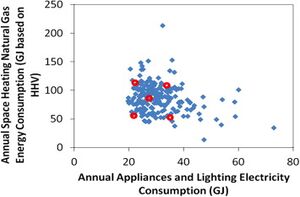
Recent work has shown that small-scale combined heat and power (CHP) and solar photovoltaic (PV) technologies have symbiotic relationships, which enable coverage of technical weaknesses while providing the potential of significant greenhouse gas emission reductions at the residential level. With the reductions in the cost of PV systems and the increasing maturity of CHP systems an opportunity exists for widespread commercialization of the technology, particularly for new construction. In order to determine the potential for this opportunity and to optimize the design of PV–CHP systems for greatest emission and cost reductions in the residential context a simulation, an optimization model has been developed using multiobjective genetic algorithms called the Photovoltaic-Trigeneration Optimization Model (PVTOM). In this paper, PVTOM is applied to emission-intensive and rapidly growing communities of Calgary, Canada. Results consistently show decreases in emissions necessary to provide both electrical and thermal energy for individual homes of all types. The savings range from 3000–9000 kg CO2e/year, which represents a reduction of 21–62% based on the type of loads in the residential household for the lowest economic cost hybrid system. These results indicate that hybrid PV–CHP technologies may serve as replacements for conventional energy systems for new communities attempting to gain access to emission-intensive grids.
See also[edit | edit source]
- PVTOM
- PVTOM Operation Instructions
- PV and CHP Literature review
- PV and CHP hybrid systems
- Hybrid photovoltaic-trigeneration systems
- A Free and open-source microgrid optimization tool: SAMA the Solar Alone Multi-Objective Advisor
- Performance of U.S. hybrid distributed energy systems: Solar photovoltaic, battery and combined heat and power
- Emerging economic viability of grid defection in a northern climate using solar hybrid systems
- Economic viability of captive off-grid solar photovoltaic and diesel hybrid energy systems for the Nigerian private sector
- The Potential for Grid Defection of Small and Medium Sized Enterprises Using Solar Photovoltaic, Battery and Generator Hybrid Systems
- Decentralized Renewable Hybrid Mini-Grids for Rural Communities: Culmination of the IREP Framework and Scale up to Urban Communities
- Low emissions analysis platform model for renewable energy: Community-scale case studies in Nigeria
- Economics of Grid-Tied Solar Photovoltaic Systems Coupled to Heat Pumps: The Case of Northern Climates of the U.S. and Canada
- Decarbonizing rural residential buildings in cold climates: A techno-economic analysis of heating electrification
- Achieving 100% Renewable and Self-Sufficient Electricity in Impoverished, Rural, Northern Climates: Case Studies from Upper Michigan, USA
- Can grid-tied solar photovoltaics lead to residential heating electrification? A techno-economic case study in the midwestern U.S.
- Adapting the European typology approach for building stock energy assessment (TABULA) concept for the developing world: The Nigerian case study
- Residential Sizing of Solar Photovoltaic Systems and Heat Pumps for Net Zero Sustainable Thermal Building Energy
- Using a Ledger to Facilitate Autonomous Peer-to-Peer Virtual Net Metering of Solar Photovoltaic Distributed Generation





